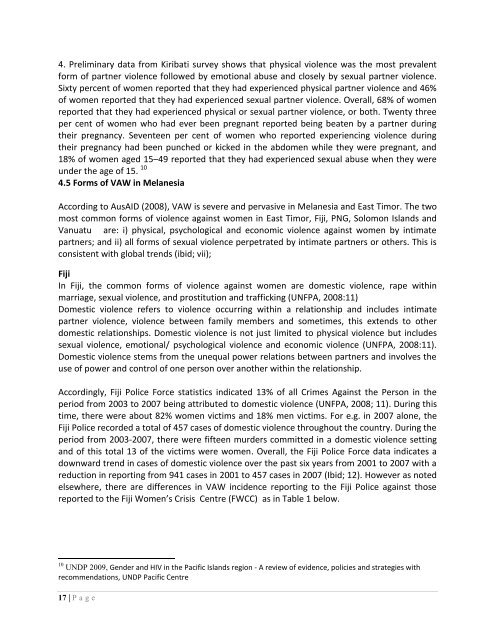Project Report â Fiji 2010 - Pacific Health Voices
Project Report â Fiji 2010 - Pacific Health Voices
Project Report â Fiji 2010 - Pacific Health Voices
You also want an ePaper? Increase the reach of your titles
YUMPU automatically turns print PDFs into web optimized ePapers that Google loves.
4. Preliminary data from Kiribati survey shows that physical violence was the most prevalent<br />
form of partner violence followed by emotional abuse and closely by sexual partner violence.<br />
Sixty percent of women reported that they had experienced physical partner violence and 46%<br />
of women reported that they had experienced sexual partner violence. Overall, 68% of women<br />
reported that they had experienced physical or sexual partner violence, or both. Twenty three<br />
per cent of women who had ever been pregnant reported being beaten by a partner during<br />
their pregnancy. Seventeen per cent of women who reported experiencing violence during<br />
their pregnancy had been punched or kicked in the abdomen while they were pregnant, and<br />
18% of women aged 15–49 reported that they had experienced sexual abuse when they were<br />
under the age of 15. 10<br />
4.5 Forms of VAW in Melanesia<br />
According to AusAID (2008), VAW is severe and pervasive in Melanesia and East Timor. The two<br />
most common forms of violence against women in East Timor, <strong>Fiji</strong>, PNG, Solomon Islands and<br />
Vanuatu are: i) physical, psychological and economic violence against women by intimate<br />
partners; and ii) all forms of sexual violence perpetrated by intimate partners or others. This is<br />
consistent with global trends (ibid; vii);<br />
<strong>Fiji</strong><br />
In <strong>Fiji</strong>, the common forms of violence against women are domestic violence, rape within<br />
marriage, sexual violence, and prostitution and trafficking (UNFPA, 2008:11)<br />
Domestic violence refers to violence occurring within a relationship and includes intimate<br />
partner violence, violence between family members and sometimes, this extends to other<br />
domestic relationships. Domestic violence is not just limited to physical violence but includes<br />
sexual violence, emotional/ psychological violence and economic violence (UNFPA, 2008:11).<br />
Domestic violence stems from the unequal power relations between partners and involves the<br />
use of power and control of one person over another within the relationship.<br />
Accordingly, <strong>Fiji</strong> Police Force statistics indicated 13% of all Crimes Against the Person in the<br />
period from 2003 to 2007 being attributed to domestic violence (UNFPA, 2008; 11). During this<br />
time, there were about 82% women victims and 18% men victims. For e.g. in 2007 alone, the<br />
<strong>Fiji</strong> Police recorded a total of 457 cases of domestic violence throughout the country. During the<br />
period from 2003-2007, there were fifteen murders committed in a domestic violence setting<br />
and of this total 13 of the victims were women. Overall, the <strong>Fiji</strong> Police Force data indicates a<br />
downward trend in cases of domestic violence over the past six years from 2001 to 2007 with a<br />
reduction in reporting from 941 cases in 2001 to 457 cases in 2007 (Ibid; 12). However as noted<br />
elsewhere, there are differences in VAW incidence reporting to the <strong>Fiji</strong> Police against those<br />
reported to the <strong>Fiji</strong> Women’s Crisis Centre (FWCC) as in Table 1 below.<br />
10 UNDP 2009, Gender and HIV in the <strong>Pacific</strong> Islands region - A review of evidence, policies and strategies with<br />
recommendations, UNDP <strong>Pacific</strong> Centre<br />
17 | P a g e
















